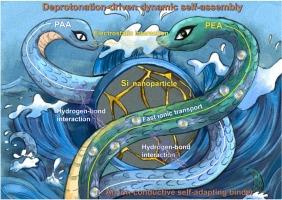Deprotonation-driven dynamic self-assembly enables an ion-conductive self-adapting binder for lithium-ion batteries
IF 17.1
1区 材料科学
Q1 CHEMISTRY, PHYSICAL
引用次数: 0
Abstract
Since traditional polymeric binders fail to alleviate the drastic volumetric changes of silica-based materials upon repeated charge/discharge cycles, dependable yet efficient binders are needed urgently to achieve high energy density LIBs. Here, an ion-conductive self-adapting binder with enhanced interfacial adhesion, fast ionic transport and dynamic structural adjust-ability is fabricated via the deprotonation-driven dynamic self-assembly. The deprotonation process results in the more stretched chains of polyacrylic acid (PAA) in PEA(polyetheramine)/PAA, and meanwhile, the robust 3D dynamic cross-linked network is established by the electrostatic bonding of -NH3+ and -COO−, as well as the hydrogen bonding of the donors and receptors. The proposed deprotonation reagent (PEA) possesses rotatable ether chains, which can not only form the flexible skeletons, but also ensure effective interaction of ether groups with Li+ to establish rapid ion transportation path. Accordingly, this new binder achieves a high adhesive shear strength while maintaining a relatively high Li+ conductivity, and therefore give it good adaptability to silica-based anodes. Furthermore, the assembled NCM811/Si/C full coin cells and full pouch cells also display high capacity and long-term stability. This work enlightens the structural design of advanced aqueous binders and paves the way for fabricating high-energy-density batteries and beyond.

去质子驱动的动态自组装使锂离子电池的离子导电自适应粘合剂成为可能
由于传统的聚合物粘结剂无法缓解硅基材料在反复充放电循环中急剧的体积变化,因此迫切需要可靠而高效的粘结剂来实现高能量密度的锂离子电池。通过去质子驱动的动态自组装,制备了一种具有增强界面附着力、快速离子传输和动态结构可调节性的离子导电自适应粘合剂。脱质子过程使PEA(聚醚胺)/PAA中的聚丙烯酸(PAA)链伸长,同时通过-NH3+和-COO−的静电键以及供体和受体之间的氢键建立了鲁棒的三维动态交联网络。所提出的去质子化试剂(PEA)具有可旋转的醚链,不仅可以形成柔性骨架,而且可以保证醚基与Li+有效相互作用,建立离子快速运输路径。因此,这种新型粘合剂在保持相对较高的Li+电导率的同时,获得了较高的粘接剪切强度,因此对硅基阳极具有良好的适应性。此外,组装的NCM811/Si/C全硬币电池和全袋电池也显示出高容量和长期稳定性。这项工作启发了先进水性粘合剂的结构设计,并为制造高能量密度电池等铺平了道路。
本文章由计算机程序翻译,如有差异,请以英文原文为准。
求助全文
约1分钟内获得全文
求助全文
来源期刊

Nano Energy
CHEMISTRY, PHYSICAL-NANOSCIENCE & NANOTECHNOLOGY
CiteScore
30.30
自引率
7.40%
发文量
1207
审稿时长
23 days
期刊介绍:
Nano Energy is a multidisciplinary, rapid-publication forum of original peer-reviewed contributions on the science and engineering of nanomaterials and nanodevices used in all forms of energy harvesting, conversion, storage, utilization and policy. Through its mixture of articles, reviews, communications, research news, and information on key developments, Nano Energy provides a comprehensive coverage of this exciting and dynamic field which joins nanoscience and nanotechnology with energy science. The journal is relevant to all those who are interested in nanomaterials solutions to the energy problem.
Nano Energy publishes original experimental and theoretical research on all aspects of energy-related research which utilizes nanomaterials and nanotechnology. Manuscripts of four types are considered: review articles which inform readers of the latest research and advances in energy science; rapid communications which feature exciting research breakthroughs in the field; full-length articles which report comprehensive research developments; and news and opinions which comment on topical issues or express views on the developments in related fields.
 求助内容:
求助内容: 应助结果提醒方式:
应助结果提醒方式:


